People
‘If I’m Going to Do This, I’ve Got to Do It Now’: Artist Mira Schor on Deciding to Tackle Monumental Artworks After Decades of Working Small
Now 70, Mira Schor is ready to take on new challenges.
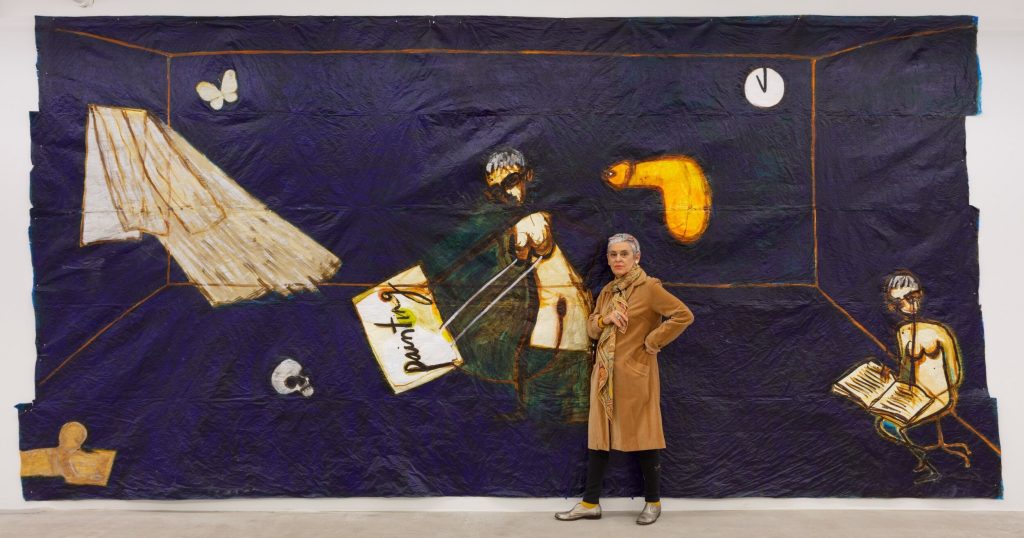
Now 70, Mira Schor is ready to take on new challenges.

Sarah Cascone

Like many Americans, artist Mira Schor spent the last four years watching in horror as former President Donald Trump turned democratic norms on their head, dividing the country with his increasingly toxic rhetoric.
The politically dominated news cycle became a driving force in her studio practice, and selections of the resulting works make up her new solo show, “Tipping Point,” at Lyles and King in New York.
One piece quotes Trump on sanctions against North Korea: “A very rough thing, very unfortunate for the world.” A piece from a series of New York Times interventions, created using pages from the newspaper, answers the headline, “Where Do Republicans Go From Here?” with the handwritten message, “straight to hell.”
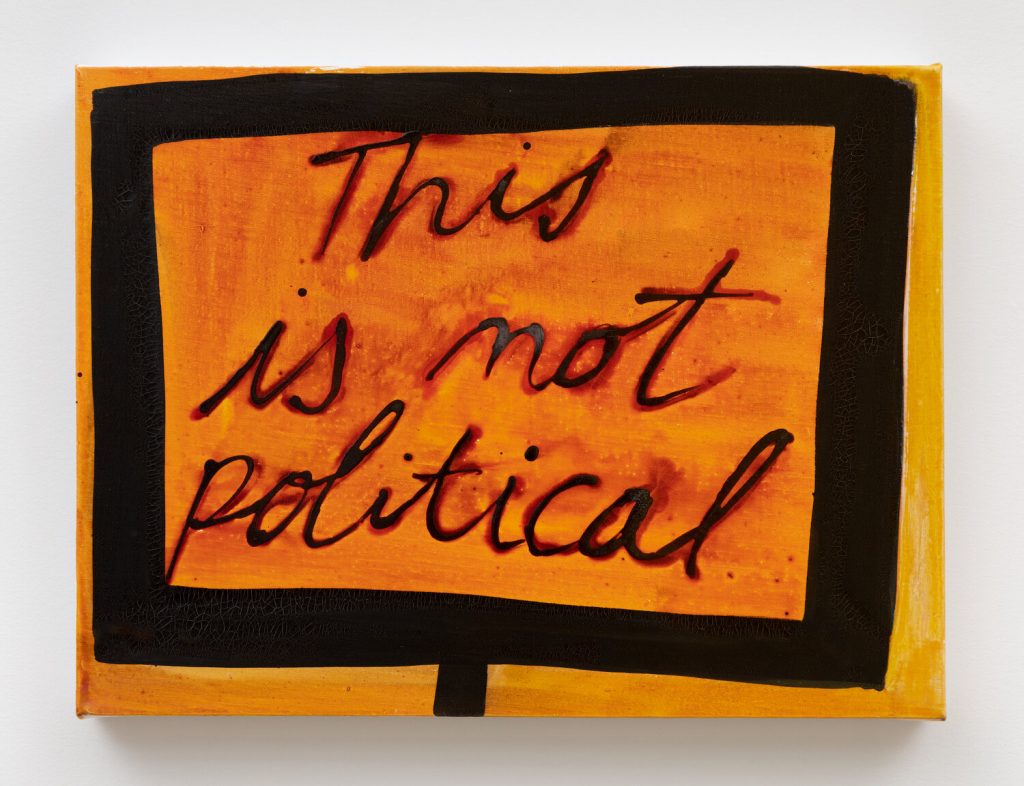
Mira Schor, This Is Not Political (2020). Photo courtesy of Lyles & King, New York.
When the gallery first proposed the exhibition late last summer, the artist was anxious about whether the work would still be relevant by the time the show opened.
“I thought, what if [Joe] Biden gets elected and everything’s okay? No one’s going to want to look back at this very dark period in our history,” Schor said. “Of course, there’s no problem with that, because we’re still in such deep trouble.”
The focal point of the show are two monumental new works, each measuring 18 feet wide—a major development for an artist who has always worked in a scale of inches, not feet. They were painted as part of a residency at Brooklyn’s Sharpe Walentas Studio Program, begun in August 2019 and extended through summer 2021.
Artnet News spoke to Schor, a lifelong New Yorker, about her current show, making work in response to current events, and what she thinks about the city—and its art scene—in 2021.
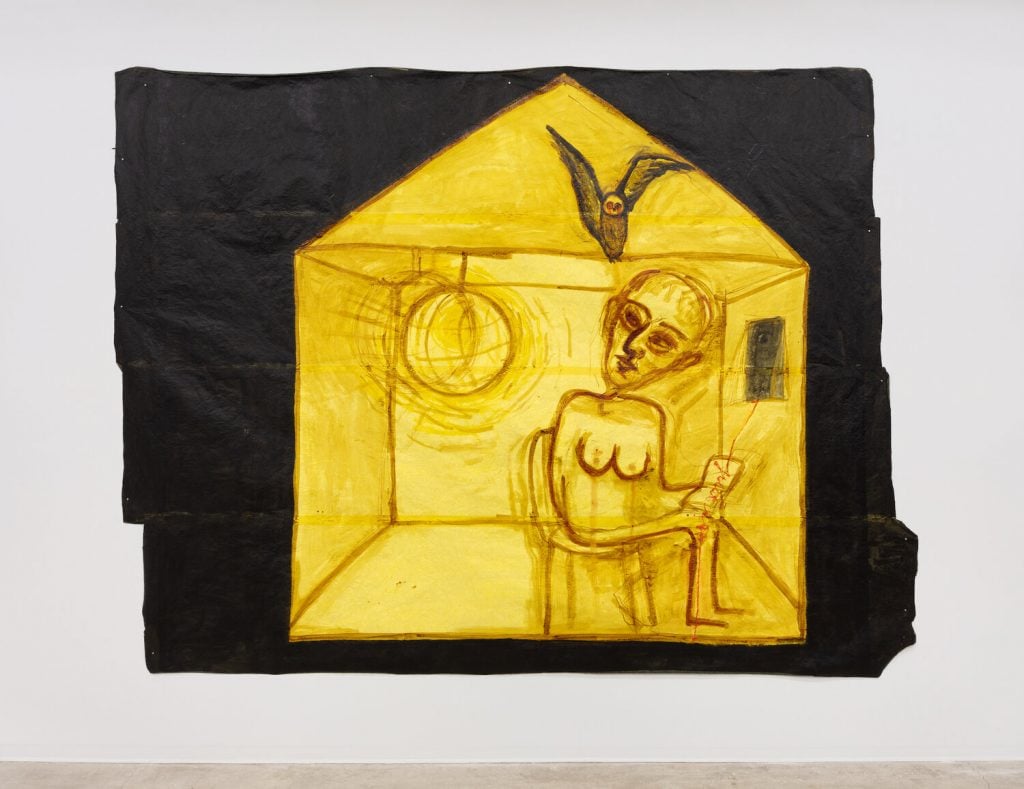
Mira Schor, A Very Large Fragile Drama (2019). Photo courtesy of Lyles & King, New York.
What were you thinking about making the works in the current show?
All of the paintings were done after Trump was inaugurated—I never call it the Trump administration, I call it the Trump regime.
I also made a series of about 200 works on craft paper that are not in the show, because they require expensive framing. I call them the Trump drawings, and I think they are a very powerful group of works. I have been very haunted by the amount of work I’ve done over the last four that has not been seen. It is a little upsetting, to feel that you’ve done something that really addressed the moment, and not have it become, at that moment, an image that people reference. I feel like these drawings won’t be seen for quite a long time, and perhaps I will not be around.
Why had you stuck to smaller works until this point in your career?
Lyles and King showed some of my early work from when I was a graduate student at Cal Arts. They were representational and narrative and personal and had a feminist impulse to them. But the fact that they were small gouache-on-paper [works] was a big issue. I did them against the art world’s concerted view that that was not painting. Painting was large, preferably abstract, on canvas—that was it.
And I kind of stuck to my guns. I devised a module for small paintings: 12 by 16 or 16 by 12, depending on how I oriented it. And I did make large works, including a work called War Frieze, which I did right after the first Gulf War. In its totality, it is 200 feet wide, but only one foot high, made of 12 by 16 modules put together.
I really had a lot of commitment to that form, wanting to show that that size could have density of meaning and could hold a wall, even from far away. But there was another part of me that always wanted to address the grand tradition of Western painting.
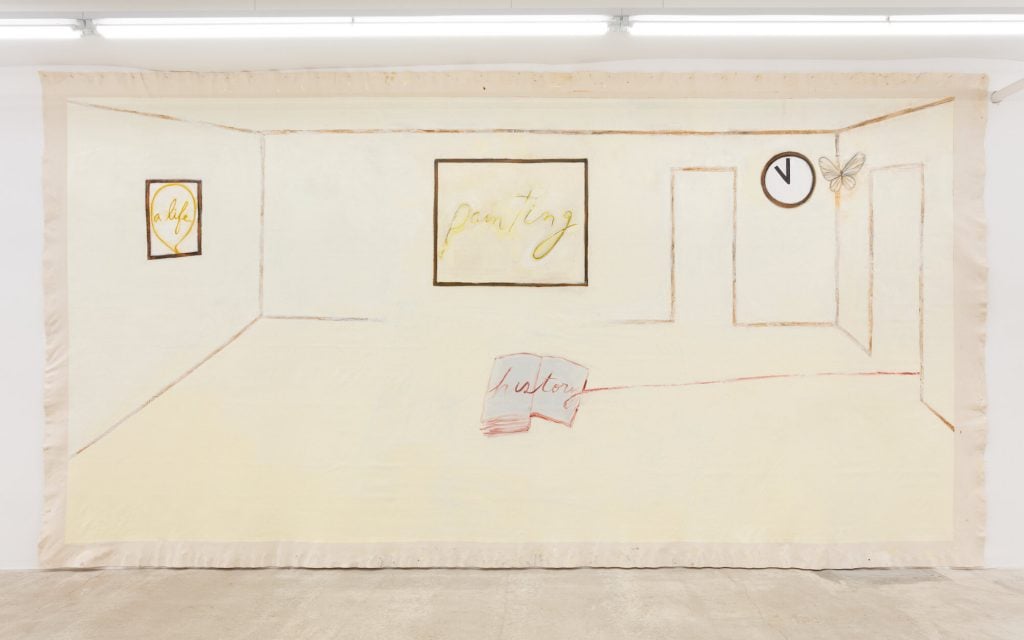
Mira Schor, After the Party’s Over (2020). Photo courtesy of Lyles & King, New York.
Why did you decide now was the time?
When I was 27, I went to Paris. There was this room at the Louvre that had kind of the apotheosis of the history of Western art, with The Painter’s Studio [by Gustave Courbet], The Raft of the Medusa [by Théodore Géricault], and The Death of Sardanapalus [by Eugène Delacroix]. That moment, I was almost completely alone in that room, and just so impressed with those paintings.
I wanted to address them in their own language, scale, and ambition, on my own terms. So I went from admiring those works, but not feeling they were something I could do, to a point where I suddenly could see and believe in myself doing very large works.
I was also thinking of my experience and my friendships with artists older than me, like Leon Golub and Ida Applebroog. Ida is still alive, still doing amazing work, but in her 70s, she began to develop physical problems that made it difficult for her to do her paintings—the physical activities that require strength and mobility, being able to get up and down. I’m 70, and I thought, okay, if I’m going to do this, I’ve got to do it now.
What have you learned working large?
It requires a lot of physical energy—and now of course, it requires even more. I can’t get any assistance in there. So if I do a painting, it sort of lies on the floor, because I can’t lift it onto the wall without any help.
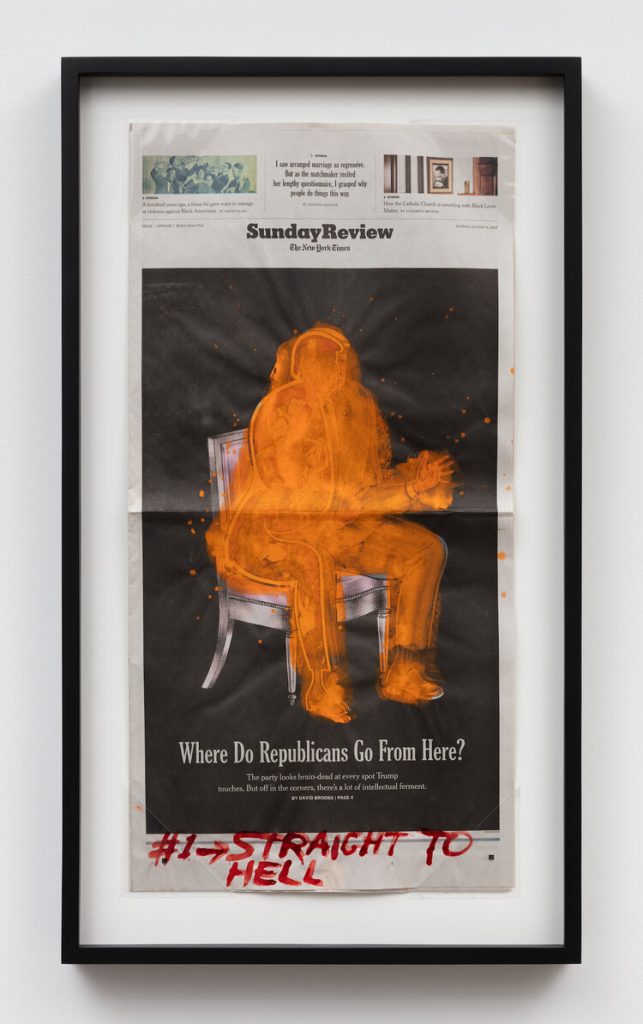
Mira Schor, New York Times Intervention (Straight to Hell, August 9, 2020)l 2020. Photo courtesy of Lyles & King, New York.
How did lockdown affect your ability to work?
I went out to the studio on March 18. It was clear that we were going to be locked out of the building. I realized I had get some art supplies that can’t be ordered online because they aren’t made anymore. A lot of my brushes are just old—I love them. I grabbed whatever I could carry.
I had to adapt to my domestic studio. It’s a decent-sized room, but not for what I’m trying to achieve right now.
We weren’t allowed back until September. At first, they were very concerned about the ventilation and the public spaces. We all have separate studios with doors and windows, but they limited how many of us could be there at a time. It was very stressful.
And I have to take three subways to get there each way! It’s like an hour trip from the Upper West Side. It takes a lot out of me to do it. I have to deal with fear, but also it’s very exhausting to be double masked for two hours a day and deal with all the people who don’t wear masks.
What is your routine like now, in terms of going out?
I have to go to the studio, but otherwise I am trying not to do very much else.
I’ve gone to a couple of museums, which feels incredibly safe because they’re completely empty, which is one of the great treats. I’ve been to MoMA twice, and both times, you could have just gone roller skating in it. I mean, I was completely alone. To me, that’s like a dream, you know?
Actually, one of the biggest risks that I’ve taken is this show. I had to be in a room with people for a few hours for a few days in a row, having these two guys come from the gallery and help pack the work, and then unpacking the work, and then supervising the hanging.
I had a “opening,” which really just meant that one or two friends might show up every 15 minutes—but still it was exposure to a lot more people in an enclosed space. Everybody was wearing masks. I’ve been wearing a KN95 with a surgical mask over it. So it’s pretty safe, one hopes.
Looking back after a year of such dramatic change, how have you seen the city evolve over the decades?
I was born in New York city. I actually live in the apartment that I grew up in, that I was brought to as a baby when I was born. I inherited my mother’s apartment and moved here 10 years ago. My parents were artists, so I preserved their studios, and added one of my own.
I lived in Tribeca for over 30 years. When I moved into my loft, it was just a room. I had to pay to have water pipes brought from the center of the building. It was illegal, but everybody was doing it. It was very rudimentary; you did the minimum to just make a place livable.
I had just one room. There was this tremendous simplicity—a unity of life. I could paint, watch TV, cook—things happened in the same place. But I got evicted, owner occupancy eviction.
How hospitable is New York to young artists today?
I treasure living in New York because I can see so much great art. And I’m glad that there are these mega-galleries that are like sort of mini museums. But I think that for young artists, they’re kind of alienating.
I teach graduate students at Parsons, and I think that the very corporate, imposing, kind of Death Star-feeling of those large galleries makes it a little less clear how you could ever get to that point. When I started to go to galleries in my late teens, and then my 20s and my 30s, 40s, it had a human scale still. You could somehow imagine how maybe you could get from A to B to C, you know?
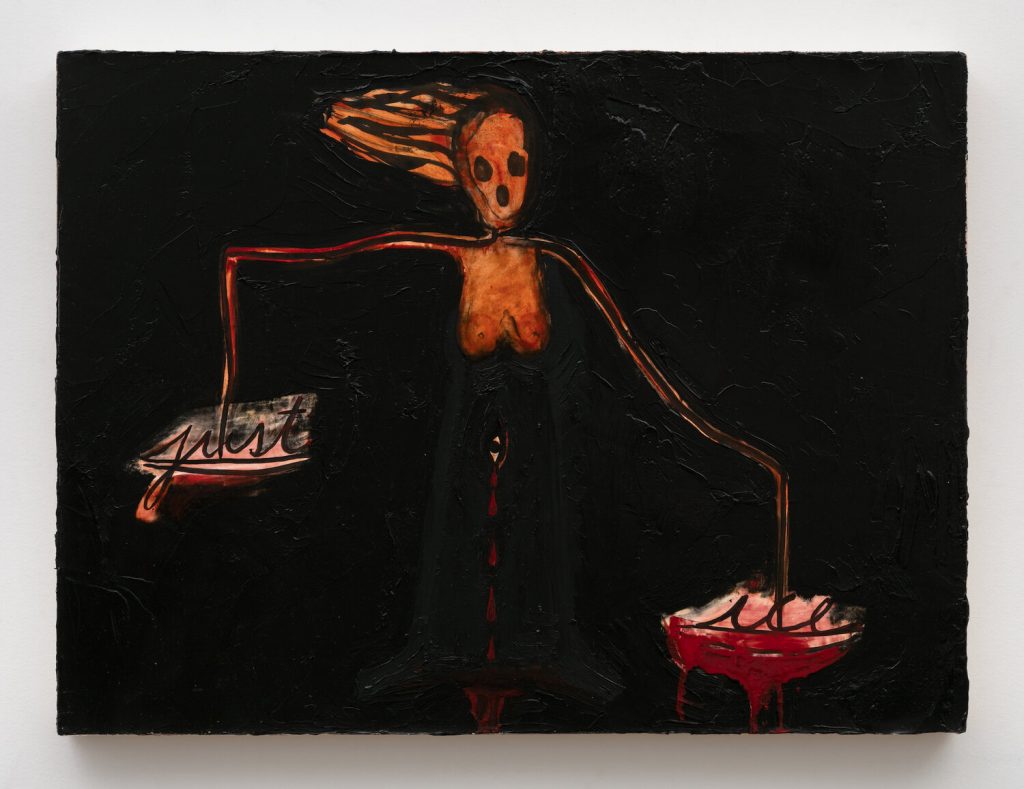
Mira Schor, Justice (2018). Photo courtesy of Lyles & King, New York.
You’ve been with Lyles and King since the gallery opened in 2015, as part of their inaugural group show. How has that relationship been compared with your past experiences with dealers?
I’ve had very, very poor exhibition career—huge gaps of time in between galleries.
I went to graduate school in California, I taught at the Nova Scotia College of Art and Design, and then I came back to New York. So I had to find my way. I was represented by Ed Thorpe Gallery for two years. Then I went like 11 years without a gallery, until I met Stuart Horodner, who was the director and co-owner of a gallery called Horodner Romley.
It was just a great place. There was a wonderful sense of community. I loved both the shows that I did there, but Stuart’s partner decided to retire and the gallery closed in 1995. I didn’t show again until 2009!
Working with Isaac [Lyles] has been the most real and consistent and focused gallery representation I’ve ever had. It’s not that easy to “get” an artist with a complex body of work, which mine is. It’s not like I’ve done one thing for 50 years and finally people go, “Oh, right. That one thing.” So I admire Isaac for taking it on, understanding it, and working to put it out into the world on a bigger stage.
“Mira Schor: Tipping Point” is on view at Lyles & King, 21 Catherine Street, New York, January 8–February 7, 2021.